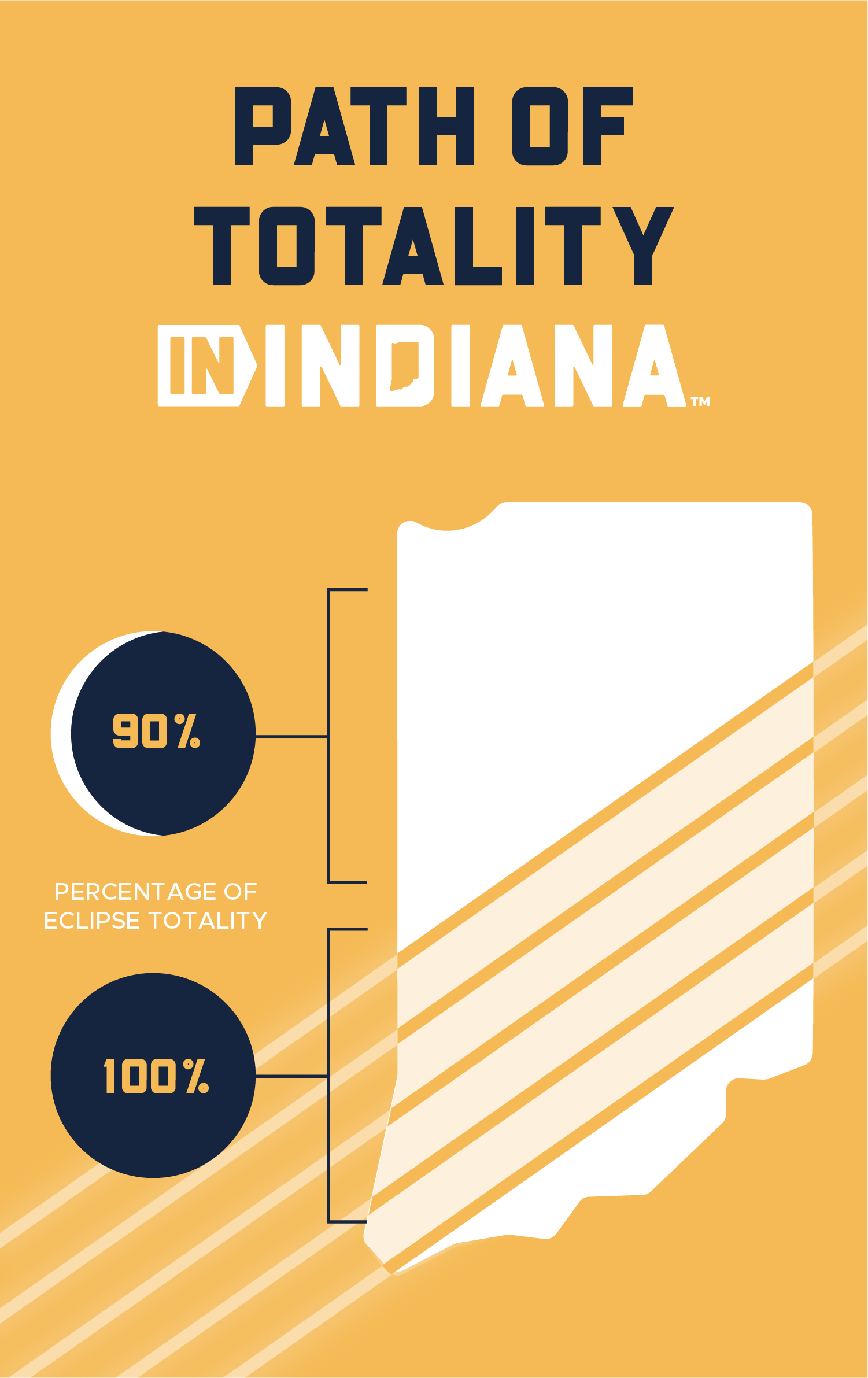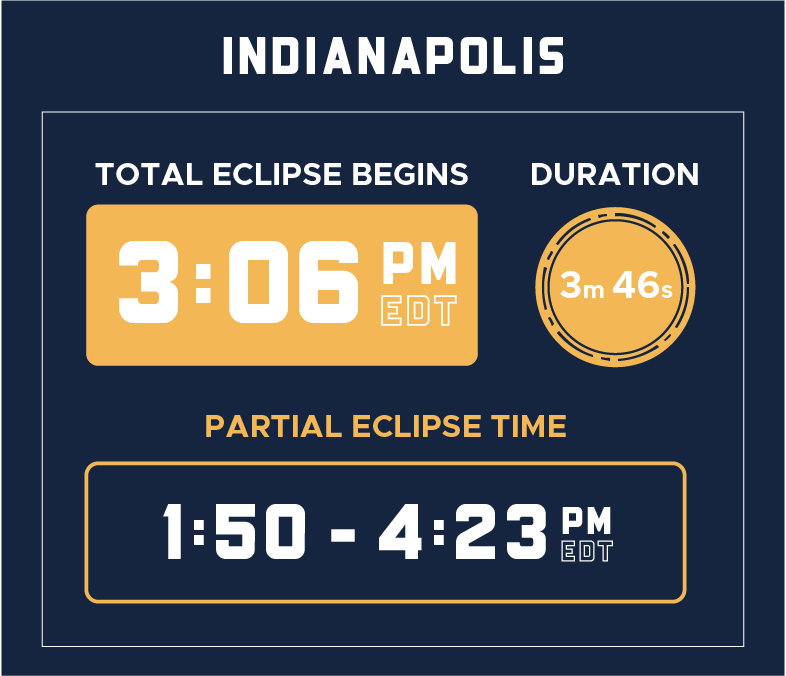Monday, April 8, 2024
~3:00 pm EDT
Experience the 2024 Solar Eclipse In Indiana
Millions of Visitors Expected Across the State
On April 8, 2024, Indiana will experience a total eclipse of the sun. The incredible occurrence will draw thousands of tourists from around the nation to our state. Every part of our state will experience either 100% totality or 90% totality, allowing everyone to witness this incredible event.
This event is the perfect opportunity to make history. Whether you choose to attend one of the many events planned across the state or plan your own viewing parties, you’ll be making memories that will last a lifetime. Don’t miss out on this incredible opportunity to be a part of history in the making!


The Time of The Eclipse
Depending on your position from east to west within the state, the start time, end time, and total duration of the eclipse will vary. The following are general timings for the eclipse across Indiana. We recommend organizing your viewing party between 1:30 pm EDT and 4:30 pm EDT to fully appreciate the entire eclipse experience in Indiana.


| Location |
Duration of Totality | Partial Eclipse Begins | Total Eclipse Begins | Partial Eclipse Ends |
|---|---|---|---|---|
| Evansville, IN | 3m 02s | 12:44pm CDT | 2:02pm CDT | 3:20pm CDT |
| Indianapolis, IN | 3m 46s |
1:50pm EDT |
3:06pm EDT | 4:23pm EDT |
| Fort Wayne, IN |
2m 46s |
1:54pm EDT | 3:08pm EDT |
4:25pm EDT |
Find Eclipse Events IN Indiana With our Solar Eclipse Map
We compiled a comprehensive 2024 Solar Eclipse viewing map, featuring great locations to visit in Indiana. Our map emphasizes free viewing sites near metropolitan areas such as Indianapolis and South Bend. It also includes scenic rural settings, such as Putnam County, and a prime location with the longest darkness, Vincennes! Start planning for an unforgettable eclipse-viewing experience on April 8th.
Tap or click to interact
Eclipse event submissions are now closed. Thank you to all who are hosting!
We wish everyone a wonderful eclipse viewing experience in Indiana!
Find the Best Places In Indiana
Discover the top viewing locations across the state, from scenic parks to the best downtowns, and plan an unforgettable eclipse experience with our comprehensive guide. Don't miss out on this rare opportunity – check out our list of the best places to view the eclipse in Indiana now!
How To Watch The Eclipse
Learn everything you need to know about watching the eclipse, from finding the perfect viewing location to protecting your eyes, and experience the awe-inspiring wonder of the universe, safely!

Event Planning Resources
Are you hosting an event or would you like to get involved in the eclipse celebrations? We want to make sure you have everything you need to plan a safe and enjoyable event. We created a comprehensive eclipse checklist to help you get connected with state and local organizations, capitalize on our resources, and leave nothing to chance.
Explore Further Details From the Indiana State Government
In.gov offers a comprehensive portal dedicated to the 2024 eclipse in Indiana. Explore safety plans, prime viewing locations, travel guidance, and more for an unforgettable celestial experience.

Did you hear about the man who stared at the eclipse without any protective glasses?
He had a dim outlook on life afterwards.
FAQ
-
The last total solar eclipse in the United States was on August 21, 2017. It was visible from Oregon to South Carolina. Outside of the USA, the last total solar eclipse was on December 14, 2020. It was visible in parts of South America and the South Pacific Ocean.
-
Yes, you can marvel at a solar eclipse – but be sure to take the necessary safety measures needed to safeguard your eyes. Looking directly at the sun during an eclipse can cause serious damage to your eyes and even blind you! It is recommended that you wear special-purpose solar filters or use indirect viewing techniques when looking at a solar eclipse.
Solar filters are designed to reduce the amount of sunlight and make it safe for direct viewing. Some examples of these filters include eclipse glasses, handheld solar viewers, and special-purpose binoculars and telescopes.
-
It's a common question, and the answer lies in the fact that the Moon's orbit around Earth is slightly tilted compared to Earth's orbit around the Sun. This means that most of the time when the Moon passes between Earth and the Sun, it doesn't completely block out our view of the Sun.
A lunar eclipse occurs when Earth is directly between the Sun and Moon, blocking sunlight from reaching the Moon. Similarly, a solar eclipse occurs when the Moon passes directly between Earth and the Sun. Both of these events are rare because they require perfect alignment of all three celestial bodies.
The tilt of our orbits also affects how often we experience eclipses. Since both eclipses occur during a full moon, they can only happen once every 29 days when there is a full moon. However, since Earth's orbit is tilted by about 5 degrees relative to that of the Moon, these eclipses don't always occur at exactly the same time each month.
In addition to this orbital tilt, there are other factors that affect how often we experience lunar or solar eclipses. For example, if an eclipse happens near one of its nodes (the points where its orbit crosses Earth’s orbital plane), then it will be more likely to be visible from certain parts of Earth than others. This means that some areas may experience more frequent eclipses than others due to their location on our planet!
So while it may seem like lunar and solar eclipses should happen every month, in reality, they are quite rare due to several factors including orbital tilt and location on our planet.
-
Total solar eclipses are a rare phenomenon, occurring on average once every 18 months. The last total solar eclipse visible in the United States was in 2017 and the next one will be in 2024. After that, it won't be until 2044 that another total solar eclipse will be visible from north America!
-
Yes and no – a solar eclipse can happen at night, but half of the planet is always in darkness, so when a solar eclipse occurs, it will be visible to those in daylight. So it’s happening but those on the “night-side” can’t see it.
A rare phenomenon known as a "midnight" partial solar eclipse has been observed in Norway and Russia. During this type of eclipse, the moon passes between Earth and the Sun, obscuring the sunlight for a few minutes and turning day into night.




